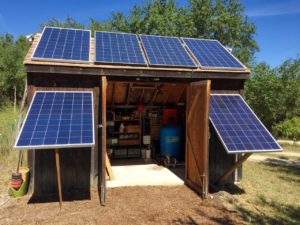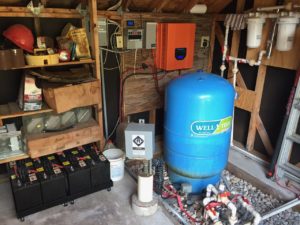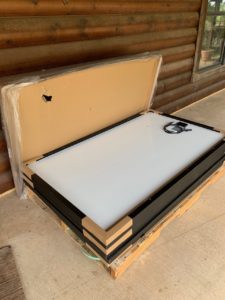A Practical 2 KW Shop Solar System

Solar Generator for Grid Down Event
Two years ago, I installed a small solar system to pump water at the ranch. This solar generator makes us independent from the grid by insuring we can always pump water — even in a grid down event. I’ve learned a lot about solar power from that project. What about refrigeration? In a power failure we cannot refrigerate food or produce ice. After last summer (2019), with the highest number of 100-degree days ever recorded in Central Texas, we need more solar power.
Because of cost, I’m not ready to build a whole-house system. On the other hand, I could build a smaller system to power the shop — including a small air conditioner. In a grid down event, the power could be routed into the house to run a refrigerator, some lighting and a few small appliances. Once in place, an extended power outage would be more tolerable.
When designing the rainwater system, I collected power usage data from the rainwater and well pumps. The system size — 1500 watts of solar panel, a 4 KW inverter, and 10,000 watt/hours of battery storage seemed reasonable. After two years of use, I’ve learned that much of that power goes to waste. The batteries are usually at or near full charge, and we’ve even been able to use the system during extended periods of overcast.
Designing the Solar System
With that in mind, I started thinking about power consumption in the shop. By far, the air conditioner is the biggest demand, at about 750 watts. Lighting is minimal with a few 30-watt LED fixtures. Power tools, and other intermittent demands, average only a few dozen watt/hours per day.
In the house, we recently replaced our refrigerator with a high-efficiency model. All of the lighting in the house is LED. Twenty years ago I was able to run an old refrigerator and some incandescent lighting easily with a 5 kilowatt (KW) gas generator. Typical modern refrigerator power consumption is between 1 and 2 KWH per day. So the load inventories look like this:
Shop:
- Air conditioner: 7-10 kilowatt-hours (KWH) per day
- LED lighting: .5 KWH/day
- Other intermittent tools: .5 KWH/day
House:
- Refrigerator: 1-2 KWH/day
- LED Lighting: 1 KWH/day
- Other intermittent loads: 2 KWH/day
- Not possible to use HVAC systems: 0 KWH/day
A Little Design Math
I started by purchasing eight 270-watt panels and a 6 KW inverter. I’ll also need 10 KWh of battery storage. How much power will the system generate per day? With the same math used for the Rainwater Solar System Design, we can predict the power generated. Starting with the basic formula:
• (Required watt-hours/day / insolation) / efficiency = total panel wattage.
We can rearrange the equation to predict the power generated by a particular panel model:
• (Panel wattage*efficiency) * insolation = watt-hours/day
With eight 270-watt panels we will generate this much per day:
• ((8 * 270-watt panels) * .67 efficiency) * 4.65 insolation = 6729 Watt-hours/day
A good match for shop power needs
So in theory, we are able to collect enough energy on a sunny day to power the shop air conditioner assuming it is cycling on and off and not running continuously. A little lighting and a few power tools should fit the power budget as well. Without doing a complete audit of the house, we should also be able to handle the essentials: refrigeration, lighting and a few intermittent loads.
As a bonus, most of the shop load will be the air conditioner. It will be needed during the hottest time of day, in the afternoon when the sun is shining brightly. This load will decline in the evening and through the night as the outdoor temperature drops. In other words, air conditioner power use correlates nicely with solar availability. Win-win.
And in the house?
The house, on the other hand, will have an intermittent, around the clock, load from the refrigerator. In addition, the greatest demand for lighting and other appliances will be in the evening. Battery storage will be crucial in both instances, although harder to predict. 10 KWh of battery storage feels like a good starting point.
The next step is to build a mounting system for the solar panels. But more on that in a future post.




Pingback:How to Mount A Solar Panel Array | Roy Creek Ranch